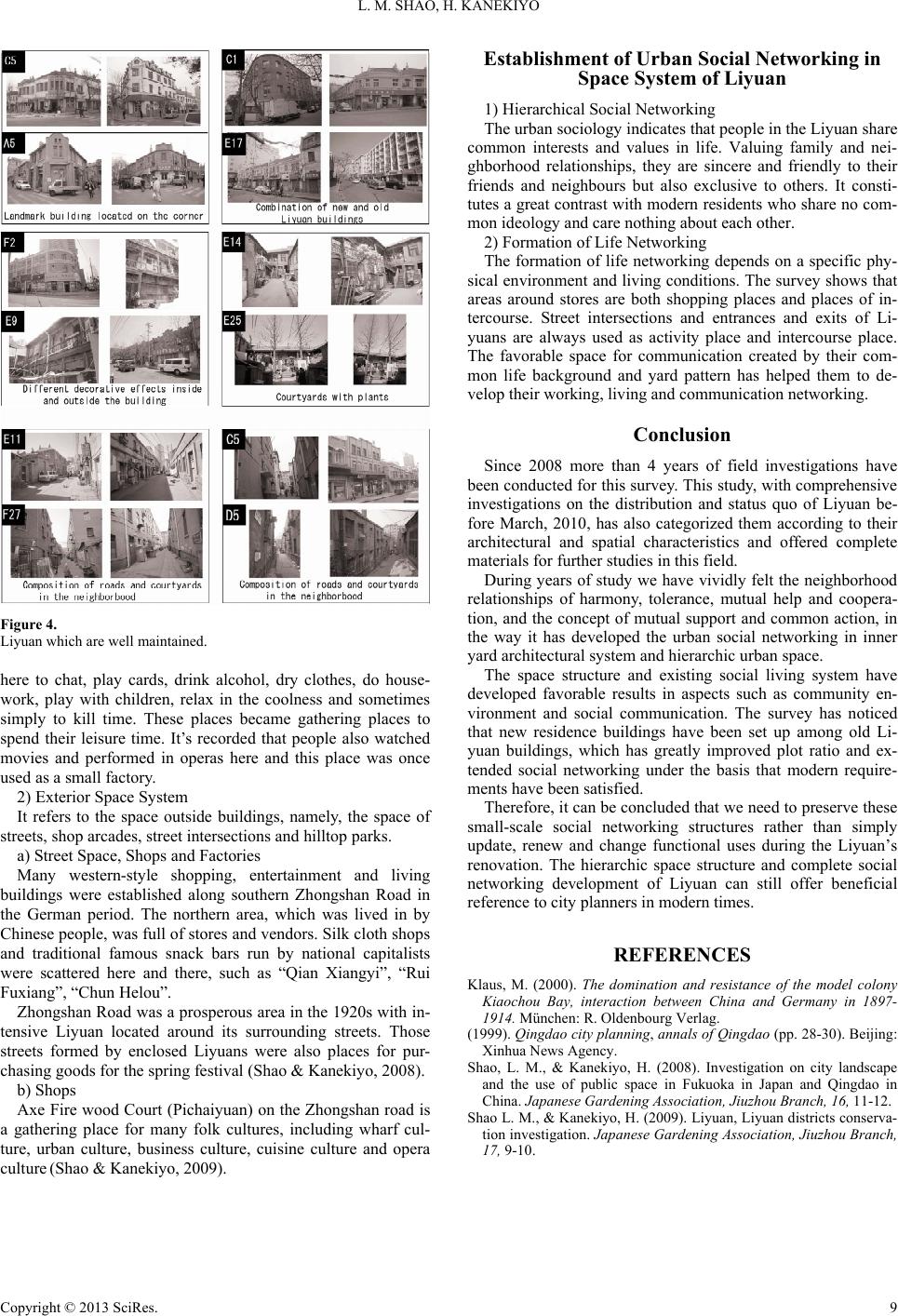
L. M. SHAO, H. KANEKIYO
Figure 4.
Liyuan which are well maintained.
here to chat, play cards, drink alcohol, dry clothes, do house-
work, play with children, relax in the coolness and sometimes
simply to kill time. These places became gathering places to
spend their leisure time. It’s recorded that people also watched
movies and performed in operas here and this place was once
used as a small factory.
2) Exterior Space System
It refers to the space outside buildings, namely, the space of
streets, shop arcades, street intersections and hilltop parks.
a) Street Space, Shops and Factories
Many western-style shopping, entertainment and living
buildings were established along southern Zhongshan Road in
the German period. The northern area, which was lived in by
Chinese people, was full of stores and vendors. Silk cloth shops
and traditional famous snack bars run by national capitalists
were scattered here and there, such as “Qian Xiangyi”, “Rui
Fuxiang”, “Chun Helou”.
Zhongshan Road was a prosperous area in the 1920s with in-
tensive Liyuan located around its surrounding streets. Those
streets formed by enclosed Liyuans were also places for pur-
chasing goods for the spring festival (Shao & Kanekiyo, 2008).
b) Shops
Axe Fire wood Court (Pichaiyuan) on the Zhongshan road is
a gathering place for many folk cultures, including wharf cul-
ture, urban culture, business culture, cuisine culture and opera
culture (Shao & Kanekiyo, 2009).
Establishment of Urban Social Networking in
Space System of Liyuan
1) Hierarchical Social Networking
The urban sociology indicates that people in the Liyuan share
common interests and values in life. Valuing family and nei-
ghborhood relationships, they are sincere and friendly to their
friends and neighbours but also exclusive to others. It consti-
tutes a great contrast with modern residents who share no com-
mon ideology and care nothing about each other.
2) Formation of Life Networking
The formation of life networking depends on a specific phy-
sical environment and living conditions. The survey shows that
areas around stores are both shopping places and places of in-
tercourse. Street intersections and entrances and exits of Li-
yuans are always used as activity place and intercourse place.
The favorable space for communication created by their com-
mon life background and yard pattern has helped them to de-
velop their working, living and communication networking.
Conclusion
Since 2008 more than 4 years of field investigations have
been conducted for this survey. This study, with comprehensive
investigations on the distribution and status quo of Liyuan be-
fore March, 2010, has also categorized them according to their
architectural and spatial characteristics and offered complete
materials for further studies in this field.
During years of study we have vividly felt the neighborhood
relationships of harmony, tolerance, mutual help and coopera-
tion, and the concept of mutual support and common action, in
the way it has developed the urban social networking in inner
yard architectural system and hierarchic urban space.
The space structure and existing social living system have
developed favorable results in aspects such as community en-
vironment and social communication. The survey has noticed
that new residence buildings have been set up among old Li-
yuan buildings, which has greatly improved plot ratio and ex-
tended social networking under the basis that modern require-
ments have been satisfied.
Therefore, it can be concluded that we need to preserve these
small-scale social networking structures rather than simply
update, renew and change functional uses during the Liyuan’s
renovation. The hierarchic space structure and complete social
networking development of Liyuan can still offer beneficial
reference to city planners in modern times.
REFERENCES
Klaus, M. (2000). The domination and resistance of the model colony
Kiaochou Bay, interaction between China and Germany in 1897-
1914. München: R. Oldenbourg Verlag.
(1999). Qingdao city planning, annals of Qingdao (pp. 28-30). Beijing:
Xinhua News Agency.
Shao, L. M., & Kanekiyo, H. (2008). Investigation on city landscape
and the use of public space in Fukuoka in Japan and Qingdao in
China. Japanese Gardening Association, Jiuzhou Branch, 16, 11-12.
Shao L. M., & Kanekiyo, H. (2009). Liyuan, Liyuan districts conserva-
tion investigation. Japanese Gardening Association, Jiuzhou Branch,
17, 9-10.
Copyright © 2013 SciRes. 9